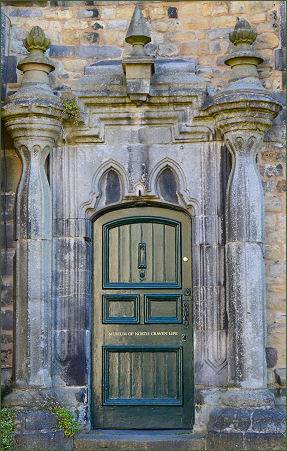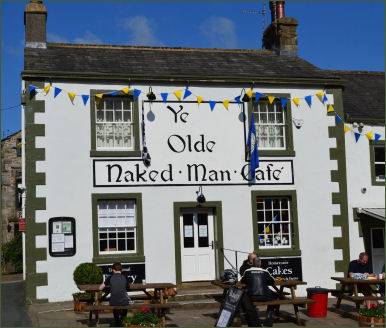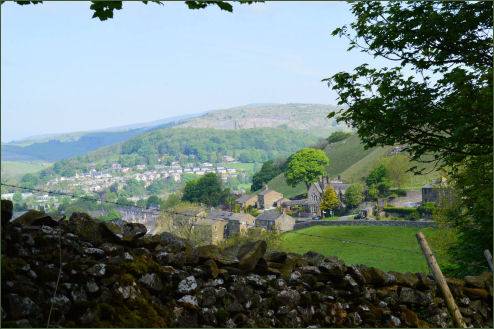Settle
OS grid reference:-
 The bustling market town of Settle is situated at the gateway to Upper Ribblesdale in the Craven district of North Yorkshire, one of the most scenic areas of the Yorkshire Dales. The town is famous as the starting point of the Settle-Carlisle Railway.
The bustling market town of Settle is situated at the gateway to Upper Ribblesdale in the Craven district of North Yorkshire, one of the most scenic areas of the Yorkshire Dales. The town is famous as the starting point of the Settle-Carlisle Railway.
The town is believed to have its origins in the seventh century, its name derives from the Anglo-Saxon word for settlement. The Domesday Book of 1086 records that Bo was the lord of Settle prior to the Norman conquest, following the Harrying of the North by William the Conqueror, in response to Saxon resistance to his rule, the estate was granted to Roger de Poitou, or Roger the Poitevin, the third son of Roger of Montgomery, 1st Earl of Shrewsbury and Mabel de Bellême, he was the brother of the notorious Robert of Bellême.
 King Henry III granted a market charter to Henry de Percy, baron of Topcliffe in 1249. A market square then developed and the main route through the medieval town was aligned on an east-west direction, from Albert Hill, Victoria Street, High Street and Cheapside and on through Kirkgate.
King Henry III granted a market charter to Henry de Percy, baron of Topcliffe in 1249. A market square then developed and the main route through the medieval town was aligned on an east-west direction, from Albert Hill, Victoria Street, High Street and Cheapside and on through Kirkgate.
During the Civil War, the Cliffords, the lords of the manor of Settle supported the Royalist cause, however the Parliamentary politician, John Lambert of Calton in Malhamdale served as a general in the Parliamentarian army army and his troops camped at Settle in August 1651 while en-route to engage the Royalists at Lancaster.
Writer and journalist Daniel Defoe (circa 1660 - 1731) wrote of the town, "Settle is the capital of an isolated little kingdom of its own surrounded by barren hills." The Settle to Carlisle Railway was built in 1875, opening to goods traffic that year and to passengers in 1876 when Settle Station was opened.
A market is held at Settle weekly on Tuesdays in Victoria Hall in the town centre. The Naked Man cafe on the market place (pictured below left), a Grade II listed building, is thought to be the oldest cafe in the country. It was once used as an inn and was built in 1663. Legend relates that the name was acquired as a man was buried naked beneath the building.
 Settle Victoria Hall is an imposing Victorian Music Hall offering drama, comedy and music, along with workshops, community events and indoor markets.
Settle Victoria Hall is an imposing Victorian Music Hall offering drama, comedy and music, along with workshops, community events and indoor markets.
The Folly, a Grade I listed building which stands on the main street, dates to the seventeenth century and was built by local lawyer Richard Preston. The Folly's unusual exterior dominates the centre of Settle and was described by Nicholas Pevsner as 'exotic', 'capricious' and 'wilful'. It was restored in 1996 and opened it to the public in 2001. The building now houses the Museum of North Craven Life and hosts exhibitions. Permanent displays include the Settle to Carlisle Railway, furniture by Robert Thompson the 'Mouseman of Kilburn', and local history.
The Gallery on the Green, situated in former red telephone kiosk, is believed to be the smallest art gallery in the world, it contains drawings, paintings and photographs. The Linton Court Gallery, situated in a former hay loft, provides a spacious setting for exhibitions. The gallery has a wide range of works for sale as well as hosting numerous artist talks throughout the year.
The Settle Storytelling Festival brings internationally known and award winning artists to Settle for families and people from all sections of the community to enjoy. In addition it also celebrates and profiles the stories of Yorkshire. The audience for the festival comes from across Britain, audiences have doubled in size since the first festival in 2010.
The town stands beside the largest outcrop of limestone in Britain, in an area of scars, cliffs, caves and potholes. A footpath leads from Settle to the summit of Castleberg Crag, which overlooks the town and provides excellent views over it.


Images courtesy of Paul Johnson
Victoria Cave
 The area around Settle has several caves where
prehistoric remains have been discovered, the most famous being Victoria Cave, so named as the inner chamber was discovered in 1837 on the day of Queen Victoria's accession to the throne.
The area around Settle has several caves where
prehistoric remains have been discovered, the most famous being Victoria Cave, so named as the inner chamber was discovered in 1837 on the day of Queen Victoria's accession to the throne.
The cave, which was discovered by chance, was found to contain remains of mammoth, bear, reindeer and hippopotamus and flint implements. In amongst the bones of reindeer was an year old antler harpoon point, the first evidence for human habitation in the Yorkshire Dales.
Some of these items, including a bear's skull found in one of the caves are now on display at Craven Museum & Gallery in Skipton.
The Roman layers of the cave, gave up a collection of unusual bronze and bone artefacts, including brooches, coins and pottery, some imported from as far away as France and Africa. Archaeologists have speculated for years as to what exactly was going on in the cave and it now seems likely that the inside was used as a shrine and there was a workshop area outside.
The cave is managed by the Yorkshire Dales National Park Authority.
Towns and Villages of Yorkshire
